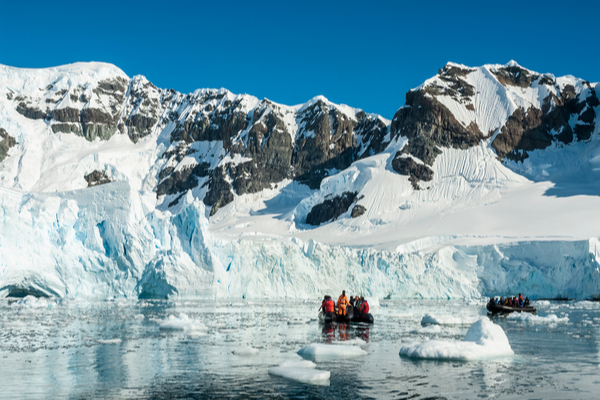One thing that’s hard to grasp about the climate crisis is that big changes can happen fast. Sometimes, in a matter of 48 hours or so, a mélange of ice about 21 miles wide and 15 miles deep can crack up and scattered into the sea. As a matter of fact, it already has – last year, as a matter of fact.
The Thwaites glacier in western Antarctica is the widest glacier on the planet Earth, about the size of Florida, spanning about 80 miles (120 kilometers) and extending to a depth of about 2,600 to 3,900 feet (800 to 1,200 meters) at its grounding line — where the glacier transitions from a land-attached ice mass to a floating ice shelf in the Amundsen Sea. It is the cork in the bottle of the entire West Antarctic ice sheet, which contains enough ice to raise sea levels by 10 feet.
Thwaites is sometimes referred to as the “Doomsday Glacier,” as its collapse could trigger a cascade of glacial collapse in Antarctica, and the latest research from the frozen continent suggests that doomsday may be coming for the dwindling glacier even sooner than expected. But as researchers reported in December at the annual meeting of the American Geophysical Union (AGU), time is melting away for this, one of Antarctica‘s biggest glaciers, and its rapid deterioration could end with the ice shelf’s complete collapse in just a few years.
Warming ocean water is not just melting Thwaites from below; it’s also loosening the glacier’s grip on the submerged seamount below, making it even more unstable. As the glacier weakens, it then becomes more prone to surface fractures that could spread until the entire ice shelf shatters “like a car window” — and that could happen as soon as three years from now, researchers said at AGU, held in New Orleans and online.
Over the last decade, observations of Thwaites showed that the glacier is changing more dramatically than any other ice and ocean system in Antarctica, thanks to human-induced climate change and increased warming in Earth’s atmosphere and oceans. Thwaites has already lost an estimated 1,000 billion tons (900 billion metric tons) of ice since 2000; its annual ice loss has doubled in the past 30 years, and it now loses approximately 50 billion tons (45 billion metric tons) more ice than it receives in snowfall per year, according to The International Thwaites Glacier Collaboration (ITGC).
If Thwaites were to break up entirely and release all its water into the ocean, sea levels worldwide would rise by more than 2 feet (65 centimeters), said ITGC lead coordinator Ted Scambos, one of the presenters at AGU and a senior research scientist at the Cooperative Institute for Research in Environmental Sciences (CIRES). “And it could lead to even more sea-level rise, up to 10 feet [3 m], if it draws the surrounding glaciers with it,” Scambos said in a statement, referring to the weakening effect one ice shelf collapse can have on other nearby glaciers.
Because Thwaites is changing so quickly and could significantly affect global sea-level rise, more than 100 scientists in the United States and the United Kingdom are collaborating on eight research projects to observe the glacier from top to bottom; results from several of those teams were presented at AGU. “We’re about at the midpoint of The International Thwaites Glacier Collaboration,” Scambos said at the briefing. “We’ve got a few more years to go to assemble further results and integrate them, so we have a better understanding of this glacier moving forward.”
These findings, as well as the ongoing work by ITGC and other scientists in Antarctica, will inform policymakers’ strategies for tracking the impacts of glacial melt on sea-level rise over the coming decades, and how that in turn will affect coastal communities around the world, according to the presenters.
While the immediate prognosis is grim for Thwaites’ ice shelf, the longterm forecast for the rest of the glacier is less certain. Should the shelf collapse, the glacier’s flow will likely accelerate in its rush toward the ocean, with parts of it potentially tripling in speed; other chain reactions could also play a part in driving accelerated ice fracturing and melt, Scambos said at AGU. But the timeframe for those changes will be decades rather than a handful of years, according to the briefing.
Meanwhile the ITGC teams will continue to monitor and analyze changes in the ongoing interplay between glacier, ice shelf and ocean on Thwaites, to help world leaders and policy makers prepare for what comes next. “That will help characterize what the next century is going to be like from this part of Antarctica,” Scambos said. “We think it’s going to be led by changes in Thwaites Glacier.”
—
Photo Credit: Foto 4440 / Shutterstock.com
